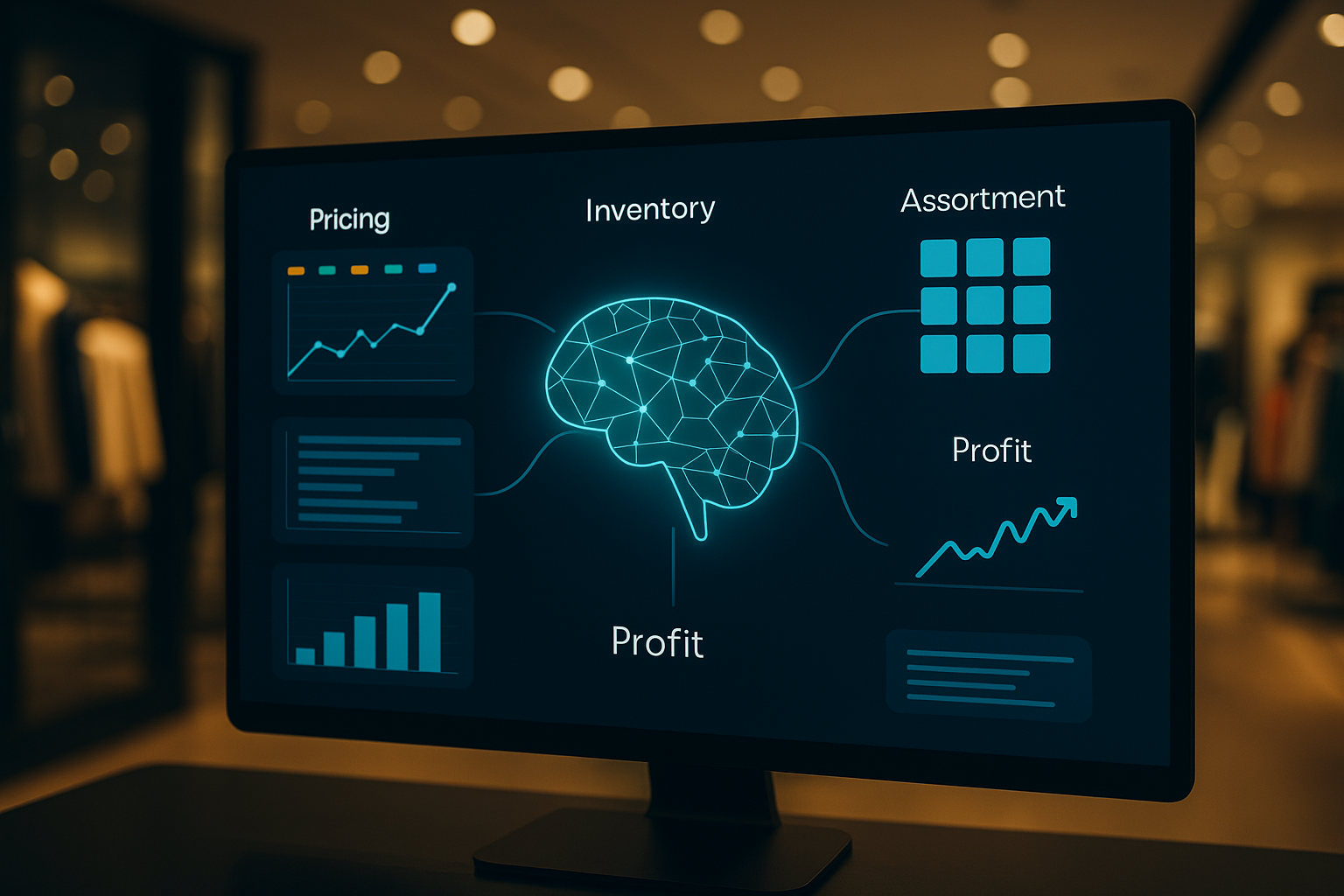Agentic AI Architecture Supporting Omnichannel Execution
Discover how agentic AI enables real-time, autonomous decision-making across retail channels. Learn how Profitmind helps brands connect insights with action.

AI spent a long time as a sort of abstract concept reserved for research labs and sci-fi. Then, seemingly overnight, it became completely essential for businesses in every industry.
Artificial intelligence is probably already shaping the way you understand demand, manage supply chains and engage your customers. You’ve probably already noticed the conversation shifting from if AI will reshape their business to how it will be structured and used responsibly.
One of the most important shifts happening right now is the move toward what’s known as agentic AI. That is, systems designed to act with autonomy while staying aligned with your (human) objectives.
Why is this shift so important? Think about the average customer today. They move between online and offline channels. They expect a consistent experience wherever they shop. Businesses like yours need to deliver a tech architecture that doesn’t just analyze all this data but also knows how to execute real-time decision making across all those channels.
Because reactive price changes that come too late are as bad for business as no change at all.
Agentic AI is an absolutely essential omnichannel tool for today’s businesses. Here’s everything you should know about how it comes into play for yours.
Why Traditional AI Architectures Fall Short
Most businesses already use AI in some form. But most of these tools and systems operate in isolation. They generate insights, and insights are exciting! But without the ability to act on them across the organization, what are those insights really doing for you?.
For example, a recommendation engine might suggest what a customer wants online. But that intelligence doesn’t always inform in-store promotions or inventory planning. A demand forecast can be accurate, but does accuracy really matter if it can’t trigger real-time supply chain adjustments?
The gap is all in the execution. Insights without coordinated action across a lot of different channels can’t deliver the seamless experiences your customers have come to expect.
So, What Makes AI “Agentic”?
Agentic AI moves past traditional models in a pretty simple way. They’re structured around decision-making and execution, not just analysis. Think about a chatbot. It’s essentially a static engine that produces outputs based on what you ask from it. But agentic AI is different. It’s designed to take action within the framework of rules and objectives you set for it.
In practice, here’s what all that really means:
- Autonomous decision loops: Your system can test, adjust and refine actions without waiting for manual prompts.
- Contextual awareness: It takes into account your full customer environment, whether that means historical behavior or live inventory data.
- Orchestration across systems: Actions aren’t siloed. Pricing, promotions, inventory and digital campaigns can all be coordinated.
The result is an architecture that’s closer to how human decision-makers operate. It’s one where you can balance information, goals and context to act in real time.
Omnichannel Execution: Meeting Customers Where They Are
Retailers often describe “omnichannel” as offering customers multiple options for engagement. But the real value lies in creating consistency and connection across those options. Customers don’t think in terms of channels — they think in terms of experiences.
For example:
- A customer browsing online expects to see accurate stock availability for their local store.
- A promotion offered via email should align with prices in-store.
- A loyalty program should apply seamlessly whether the customer shops on a phone, desktop, or point-of-sale terminal.
Omnichannel execution is about making those connections seamless. To do this, companies need systems that can act on unified intelligence across every point of interaction. Agentic AI is uniquely suited to this because it can execute decisions consistently across digital and physical environments.
The Architecture Behind It
So how does an agentic AI architecture actually support omnichannel execution? A few layers stand out:
- Data Integration Layer
All channels feed into a shared data backbone. This breaks down silos and provides a single view of customer behavior, inventory, and market conditions. - Decision Engine
Here, AI agents apply models and rules to generate actions. Because they’re agentic, they don’t just suggest — they execute across systems within predefined guardrails. - Execution Connectors
These are the bridges into retail systems: POS, e-commerce platforms, campaign management tools, and supply chain systems. Agentic AI architectures need to connect into all of these to deliver true omnichannel outcomes. - Feedback Loops
Every action becomes data for the next cycle. Prices adjusted in real time, campaigns that land with specific audiences, or stock reallocated to meet demand — all of it feeds back into the system to refine future decisions.
It’s this continuous loop of sensing, deciding, acting, and learning that defines an effective architecture.
Practical Outcomes for Retailers and Brands
Moving from concept to practice, what does agentic AI mean for business outcomes? A few examples highlight its impact:
- Pricing: Real-time adjustments across digital and in-store environments, keeping prices competitive but also protecting margins.
- Inventory: Smarter allocation of stock based on live demand signals across all channels, reducing both shortages and overstock.
- Promotions: Campaigns that adjust pricing dynamically, offering the right incentive to the right customer at the right time.
- Customer Experience: Personalized journeys that remain consistent, whether a customer is interacting online, on mobile, or face to face.
The thread across all of these is execution. Insights become actions without delay, improving efficiency and customer satisfaction at once.
The Role of Guardrails
Of course, autonomy without accountability isn’t smart or viable. Effective agentic AI architectures operate within clear boundaries that are set by human decision-makers. These guardrails help make sure that decisions stay aligned with business goals, ethical standards, and regulatory requirements.
For retailers, that might mean setting parameters around price floors, promotion frequency or inventory thresholds. The AI can act with autonomy within those boundaries, but always in a way that reflects your organization’s strategy and values.
Where Profitmind Fits In
Profitmind works with retailers and brands that want to move beyond static insights to real-time, coordinated execution. The company’s platform is built around agentic AI principles, integrating decision-making with omnichannel action.
By structuring AI around execution, Profitmind helps businesses deliver consistent experiences while improving operational efficiency. Rather than building isolated point solutions, the approach is designed to connect pricing, promotions, and inventory into one coordinated system.
For customers, this means experiences that feel more seamless. For you it means strategies that will adapt dynamically without that need for constant manual intervention.
Looking Ahead
As retail becomes more complex, the pressure to deliver consistent experiences across every channel will only grow. Traditional AI models focused on narrow use cases just can’t keep up with this pace.
Agentic AI architectures that support omnichannel execution represent a meaningful step forward. They provide the flexibility and intelligence needed to respond to customers in real time, while still keeping human decision-makers in control.
If you’re really serious about creating seamless experiences and staying competitive in fast-moving markets, investing in this type of architecture is a must. It’s fast becoming the foundation for how retail will operate today, tomorrow and well into the future.
Ready to learn more? We’re just one message away.
See why Profitmind's retail AI technology pays for itself in the first month
Discover More

Real-World Agentic AI Examples in Retail Optimization
See how agentic AI transforms retail by turning data into real actions. Learn how teams use AI to improve pricing, assortment, and inventory decisions in 2025.

Why Agentic AI Is the Next Leap in Retail Decision-Making
Discover how agentic AI helps retailers turn data into clear, profitable actions. Learn how intelligent agents improve pricing, assortment, and inventory decisions.

Retail AI Agents Coordinating Category-Level Growth
See how coordinated retail AI agents align pricing, promotions, and inventory to drive category-level growth and sustainable profits with Profitmind.

